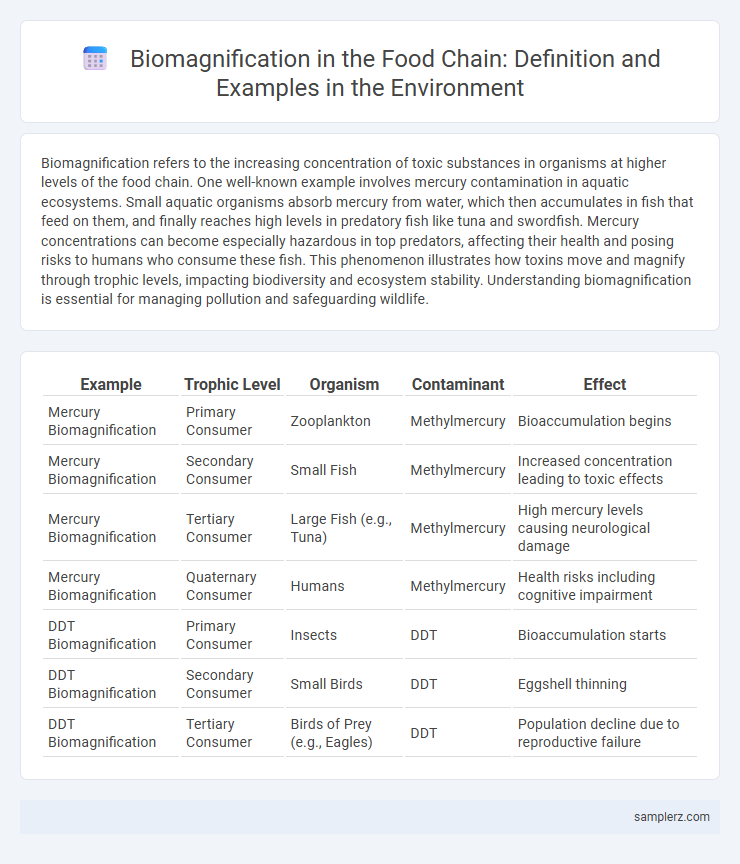Biomagnification refers to the increasing concentration of toxic substances in organisms at higher levels of the food chain. One well-known example involves mercury contamination in aquatic ecosystems. Small aquatic organisms absorb mercury from water, which then accumulates in fish that feed on them, and finally reaches high levels in predatory fish like tuna and swordfish. Mercury concentrations can become especially hazardous in top predators, affecting their health and posing risks to humans who consume these fish. This phenomenon illustrates how toxins move and magnify through trophic levels, impacting biodiversity and ecosystem stability. Understanding biomagnification is essential for managing pollution and safeguarding wildlife.
Table of Comparison
| Example | Trophic Level | Organism | Contaminant | Effect |
|---|---|---|---|---|
| Mercury Biomagnification | Primary Consumer | Zooplankton | Methylmercury | Bioaccumulation begins |
| Mercury Biomagnification | Secondary Consumer | Small Fish | Methylmercury | Increased concentration leading to toxic effects |
| Mercury Biomagnification | Tertiary Consumer | Large Fish (e.g., Tuna) | Methylmercury | High mercury levels causing neurological damage |
| Mercury Biomagnification | Quaternary Consumer | Humans | Methylmercury | Health risks including cognitive impairment |
| DDT Biomagnification | Primary Consumer | Insects | DDT | Bioaccumulation starts |
| DDT Biomagnification | Secondary Consumer | Small Birds | DDT | Eggshell thinning |
| DDT Biomagnification | Tertiary Consumer | Birds of Prey (e.g., Eagles) | DDT | Population decline due to reproductive failure |
Introduction to Biomagnification in Food Chains
Biomagnification occurs when toxic substances like mercury or DDT accumulate at higher concentrations in organisms higher up the food chain, starting from contaminated water or soil. Small aquatic organisms absorb these pollutants, which are then consumed by fish, progressively increasing toxin concentration with each trophic level. This process poses significant risks to top predators, including birds of prey and humans.
Understanding How Biomagnification Occurs
Mercury accumulates in aquatic ecosystems as small organisms absorb it from water and sediments, progressively increasing concentrations in fish that consume them. Predatory fish like tuna and swordfish exhibit higher mercury levels due to biomagnification, posing health risks to humans who consume them. This process occurs because contaminants concentrate at each trophic level, reflecting the inability of organisms to eliminate persistent pollutants.
Mercury Accumulation in Aquatic Food Chains
Mercury accumulation in aquatic food chains exemplifies biomagnification, where inorganic mercury is converted to toxic methylmercury by microorganisms and progressively concentrates in fish tissues. Predatory fish such as tuna and swordfish exhibit mercury levels thousands of times higher than surrounding water, posing significant health risks to human consumers. This process disrupts ecosystems and highlights the urgent need for mercury emission controls to safeguard aquatic biodiversity and public health.
DDT Persistence and Its Impact on Birds of Prey
DDT, a persistent organochlorine pesticide, accumulates in aquatic ecosystems and biomagnifies through the food chain, resulting in elevated concentrations in predatory birds like eagles and falcons. This chemical disrupts calcium metabolism, causing eggshell thinning, reduced hatching success, and population declines in birds of prey. Monitoring DDT residue levels in top predators remains crucial for assessing ecosystem health and the long-term impact of persistent organic pollutants.
PCBs and Their Effects in Marine Ecosystems
Polychlorinated biphenyls (PCBs) accumulate through biomagnification in marine food chains, starting from plankton and moving up to fish and marine mammals. These persistent organic pollutants disrupt endocrine systems, impair reproduction, and cause immune deficiencies in species like seals and orcas. Elevated PCB concentrations threaten biodiversity and overall health of marine ecosystems, highlighting the need for stringent pollution control measures.
Heavy Metals in Terrestrial Food Webs
Heavy metals such as mercury, lead, and cadmium accumulate through biomagnification in terrestrial food webs, starting from contaminated soil and vegetation consumed by herbivores. Predatory animals like wolves and hawks ingest these metals at higher concentrations as they feed on contaminated prey, leading to toxic effects and reproductive issues. Soil contamination from industrial activities significantly accelerates the bioaccumulation of heavy metals in terrestrial ecosystems.
Case Study: Cadmium in Agricultural Food Chains
Cadmium accumulation in agricultural food chains exemplifies biomagnification, where this toxic heavy metal enters soil through phosphate fertilizers and contaminated irrigation water. Crops like rice and leafy vegetables absorb cadmium, which then concentrates in herbivorous animals and amplifies further in higher trophic levels such as humans consuming these plants and animals. Long-term cadmium exposure through this food chain leads to severe health risks including kidney damage and bone demineralization.
Microplastics Transfer Across Trophic Levels
Microplastics accumulate in marine organisms, starting with plankton ingesting microscopic particles, which then transfer to small fish and progressively to larger predators such as seabirds and marine mammals. This trophic transfer results in biomagnification, where microplastic concentrations and associated toxic contaminants increase at higher levels of the food chain. The presence of microplastics in apex predators indicates widespread ecological risks and highlights the urgent need for mitigation strategies targeting plastic pollution in aquatic ecosystems.
Human Health Risks from Biomagnification
Mercury accumulation in fish exemplifies biomagnification, where higher trophic levels like humans consume contaminated seafood, leading to increased mercury exposure. This poses significant health risks including neurological damage, cognitive impairments, and developmental delays, particularly in pregnant women and children. Monitoring and limiting consumption of large predatory fish such as swordfish and tuna is essential to reduce mercury-related health hazards.
Strategies for Reducing Biomagnification in Ecosystems
Implementing stricter regulations on pesticide and heavy metal discharges can significantly reduce biomagnification in aquatic and terrestrial ecosystems. Promoting phytoremediation and bioremediation techniques helps break down pollutants before they enter the food chain, minimizing toxin accumulation in wildlife. Restoring wetlands and natural habitats increases biodiversity, which can dilute contaminant concentrations and disrupt the transfer of harmful substances through trophic levels.

example of biomagnification in food chain Infographic
 samplerz.com
samplerz.com